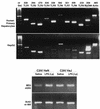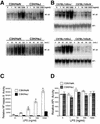Role of toll-like receptors in changes in gene expression and NF-kappa B activation in mouse hepatocytes stimulated with lipopolysaccharide
- PMID: 12065483
- PMCID: PMC128073
- DOI: 10.1128/IAI.70.7.3433-3442.2002
Role of toll-like receptors in changes in gene expression and NF-kappa B activation in mouse hepatocytes stimulated with lipopolysaccharide
Abstract
The liver is an important site of host-microbe interaction. Although hepatocytes have been reported to be responsive to lipopolysaccharide (LPS), the global gene expression changes by LPS and mechanism(s) by which LPS stimulates cultured hepatocytes remain uncertain. Cultures of primary mouse hepatocytes were incubated with LPS to assess its effects on the global gene expression, hepatic transcription factors, and mitogen-activated protein (MAP) kinase activation. DNA microarray analysis indicated that LPS modulates the selective expression of more than 80 genes and expressed sequence tags. We have shown previously that hepatocytes express CD14, which is required both for uptake and responsiveness to LPS. In other cells, responsiveness to microbial products requires expression of Toll-like receptors (TLR) and their associated accessory molecules. Hepatocytes expressed TLR1 through TLR9 as well as MyD88 and MD-2 transcripts, as shown by reverse transcriptase PCR analysis, indicating that hepatocytes express all known microbe recognition molecules. The MAP kinase extracellular signal-regulated kinase 1/2 was phosphorylated in response to LPS in mouse hepatocytes, and the levels of phosphorylation were lower in hepatocytes from TLR4-null mice. NF-kappa B activation was reduced in TLR4-mutant or -null hepatocytes compared to control hepatocytes, and this defect was partially restored by adenoviral transduction of mouse TLR4. Thus, hepatocytes respond to nanogram concentrations of LPS through a TLR4 response pathway.
Figures




Similar articles
-
The role of MyD88 and TLR4 in the LPS-mimetic activity of Taxol.Eur J Immunol. 2001 Aug;31(8):2448-57. doi: 10.1002/1521-4141(200108)31:8<2448::aid-immu2448>3.0.co;2-n. Eur J Immunol. 2001. PMID: 11500829
-
Toll-like receptor 4 mediates inflammatory signaling by bacterial lipopolysaccharide in human hepatic stellate cells.Hepatology. 2003 May;37(5):1043-55. doi: 10.1053/jhep.2003.50182. Hepatology. 2003. PMID: 12717385
-
Induction of in vitro reprogramming by Toll-like receptor (TLR)2 and TLR4 agonists in murine macrophages: effects of TLR "homotolerance" versus "heterotolerance" on NF-kappa B signaling pathway components.J Immunol. 2003 Jan 1;170(1):508-19. doi: 10.4049/jimmunol.170.1.508. J Immunol. 2003. PMID: 12496438
-
Toll-like receptors; their physiological role and signal transduction system.Int Immunopharmacol. 2001 Apr;1(4):625-35. doi: 10.1016/s1567-5769(01)00010-8. Int Immunopharmacol. 2001. PMID: 11357875 Review.
-
Toll and Toll-like proteins: an ancient family of receptors signaling infection.Rev Immunogenet. 2000;2(3):294-304. Rev Immunogenet. 2000. PMID: 11256741 Review.
Cited by
-
TLR4 Deficiency Protects against Hepatic Fibrosis and Diethylnitrosamine-Induced Pre-Carcinogenic Liver Injury in Fibrotic Liver.PLoS One. 2016 Jul 8;11(7):e0158819. doi: 10.1371/journal.pone.0158819. eCollection 2016. PLoS One. 2016. PMID: 27391331 Free PMC article.
-
New concepts in the immunopathogenesis of chronic hepatitis B: the importance of the innate immune response.Hepatol Int. 2008 May;2(Supplement 1):12-8. doi: 10.1007/s12072-008-9067-0. Epub 2008 Feb 27. Hepatol Int. 2008. PMID: 19669294 Free PMC article.
-
Innate antiviral immune responses to hepatitis B virus.Viruses. 2010 Jul;2(7):1394-1410. doi: 10.3390/v2071394. Epub 2010 Jul 5. Viruses. 2010. PMID: 21994686 Free PMC article.
-
Hepatitis C and innate immunity: recent advances.Clin Liver Dis. 2008 Aug;12(3):675-92, x. doi: 10.1016/j.cld.2008.03.003. Clin Liver Dis. 2008. PMID: 18625434 Free PMC article.
-
Effect of polyI:C cotreatment on halothane-induced liver injury in mice.Hepatology. 2009 Jan;49(1):215-26. doi: 10.1002/hep.22585. Hepatology. 2009. PMID: 19111017 Free PMC article.
References
-
- Arizono, K., S. Kagawa, H. Hamada, and T. Ariyoshi. 1995. Nitric oxide mediated metallothionein induction by lipopolysaccharide. Res. Commun. Mol. Pathol. Pharmacol. 90:49-58. - PubMed
-
- Beg, A. A., and D. Baltimore. 1996. An essential role for NF-κB in preventing TNF-alpha-induced cell death. Science 274:782-784. - PubMed
-
- Beg, A. A., W. C. Sha, R. T. Bronson, S. Ghosh, and D. Baltimore. 1995. Embryonic lethality and liver degeneration in mice lacking the RelA component of NF-kappa B. Nature 376:167-170. - PubMed
-
- Begbie, M., C. Notley, S. Tinlin, L. Sawyer, and D. Lillicrap. 2000. The factor VIII acute phase response requires the participation of NFκB and C/EBP. Thromb. Haemost. 84:216-222. - PubMed
-
- Beutler, B. 2000. Tlr4: central component of the sole mammalian LPS sensor. Curr. Opin. Immunol. 12:20-26. - PubMed
Publication types
MeSH terms
Substances
Grants and funding
LinkOut - more resources
Full Text Sources
Research Materials

